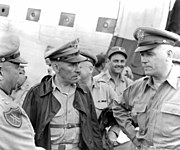| Joseph Lawton Collins | |
|---|---|
 General J. Lawton Collins | |
| Nickname | "Lightning Joe" |
| Born | May 1, 1896 |
| Died | September 12, 1987 (aged 91) |
| Place of birth | New Orleans, Louisiana |
| Place of death | Washington, D.C. |
| Place of burial | Arlington National Cemetery |
| Allegiance |
|
| Service/branch | U.S. Army |
| Years of service | 1917–1956 |
| Rank |
|
| Commands held |
3rd Battalion 22nd Infantry Chief of Staff of the US Army |
| Battles/wars | World War II |
| Awards |
|
Joseph "Lightning Joe" Lawton Collins (May 1, 1896 – September 12, 1987) was Army Chief of Staff during the Korean War. During World War II, he was an Army general,[1] serving in both the Pacific and European Theaters of Operations.
His elder brother, James Lawton Collins, was also in the Army as a major general. His nephew, Michael Collins, was the command module pilot on the Apollo 11 mission in 1969 that put the first two men on the Moon and would retire as a brigadier general from the Air Force.
Early career[]
Collins was born in New Orleans, Louisiana, on May 1, 1896. He graduated from the United States Military Academy in 1917; was commissioned a second lieutenant and assigned to the 22nd Infantry, April 1917; was promoted to first lieutenant, May 1917, and temporary captain, August 1917. He attended the Infantry School of Arms at Fort Sill and served with his regiment at various locations, 1917–1919. Collins was promoted to captain, June 1918, and to temporary major, September 1918; commanded the 3rd Battalion, 22nd Infantry, in France, 1919, and was assistant chief of staff, G-3, of American Forces in Germany, 1920–1921.
During this time Collins served in the Army of Occupation with the Philippine Scouts in Germany.[2]
Advancement[]
Collins married Gladys Easterbrook, 1921; reverted to captain, 1920; was instructor in the department of chemistry at West Point, 1921–1925; graduated from the company officer course at the Infantry School, Fort Benning, 1926, and from the advanced course at the Field Artillery School, Fort Sill, 1927. He was an instructor in weapons and tactics at the Infantry School, 1927–1931; was promoted to major, August 1932; was executive officer of the 23rd Brigade, Manila, and assistant chief of staff, G-2, Philippine Division, 1933–1934.
He graduated from the Army Industrial College, 1937, and the Army War College, 1938; was an instructor at the Army War College, 1938–1940. He was promoted to lieutenant colonel, June 1940; was chief of staff of the VII Corps, 1941.
Major commands[]

Omar Bradley & Collins at Cherbourg, June 1944
Collins was promoted to the temporary ranks of colonel, January 1941, brigadier general, February 1942, and major general, May 1942.
He was chief of staff of the Hawaiian Department, 1941–1942, and commanding general of the 25th Infantry Division—the "Tropic Lightning" Division—on Oahu and in operations against the Japanese on Guadalcanal, 1942–1943 and on New Georgia in from July to October 1943.
Transferred to Europe, he commanded VII Corps in the Normandy invasion and in Western European campaigns to the German surrender, 1944–1945. VII Corps is best known for the leading role it played in Operation Cobra; less well known is Collins' contribution to that plan.
Collins was promoted to temporary lieutenant general (April) and permanent brigadier general (June), 1945. He was deputy commanding general and chief of staff of Army Ground Forces, August – December 1945; was director of information (later chief of public information) of the Army, 1945–1947; was deputy (later vice) chief of staff of the United States Army, 1947–1949; was promoted to temporary general and permanent major general, January 1948.

Collins with Walton Walker and John H. Church in Korea
Collins was chief of staff of the United States Army, August 16, 1949 – August 15, 1953; as such he was the Army's senior officer throughout the Korean War.
He directed the Army's operation of the railroads, brought the first Special Forces group into the order of battle, and was closely associated with the development of the Army's contribution to the newly established North Atlantic Treaty Organization.
He was representative of the United States to the Military Committee and the Standing Group of NATO, 1953–1954; was special representative of the United States in Vietnam with ambassadorial rank, 1954–1955; returned to his NATO assignment; retired from active service, March 1956.
Collins died in Washington, D.C., on September 12, 1987. He is buried at Arlington National Cemetery.[3]
Notes[]
- ↑ "Video: Dragon's Teeth". U.S. Army Pictorial Service. http://www.archive.org/details/gov.dod.dimoc.30141. Retrieved February 21, 2012.
- ↑ Edwards, Paul M. (2010). Historical Dictionary of the Korean War. Volume 41 of Historical Dictionaries of War, Revolution, and Civil Unrest. Scarecrow Press. p. 65. ISBN 9780810874619. http://books.google.com/books?id=scZN59DXeOwC&lpg=PA163&dq=Philippine%20%22Korean%20War%22&pg=PA65#v=onepage&q=Philippine%20%22Korean%20War%22&f=false. Retrieved 19 March 2013.
- ↑ Findagrave.com. http://www.findagrave.com/cgi-bin/fg.cgi?page=gr&GRid=51335830&rand=333
References[]
- Joseph Lawton Collins (1969). War in peacetime: the history and lessons of Korea.
External links[]
| Wikimedia Commons has media related to J. Lawton Collins. |
- Joseph Lawton Collins biography in Commanding Generals and Chiefs of Staff a publication of the United States Army Center of Military History
- Arlington National Cemetery Biography
- Conversations with General J. Lawton Collins, Combat Studies Institute report
- Papers of J. Lawton Collins, Dwight D. Eisenhower Presidential Library
- Papers of John J. Walsh (Aide-de-Camp to J. Lawton Collins), Dwight D. Eisenhower Presidential Library
- [1]
- A film clip AIR ASSAULT TACTICS ETC. (1945) is available for free download at the Internet Archive [more]
The original article can be found at J. Lawton Collins and the edit history here.

